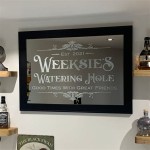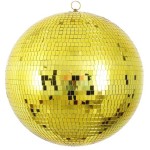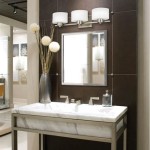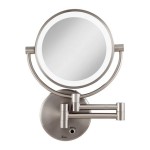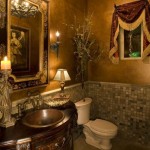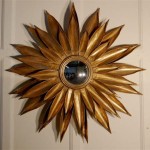How To Angle A Mirror On Wall
Angling a mirror on a wall, whether for aesthetic purposes or functional reasons, requires careful consideration and precise execution. Properly angling a mirror can maximize light reflection, create the illusion of space, or enhance the viewing angle. This article will explore various methods and considerations for achieving the perfect mirror angle.
Understanding the Purpose
Before embarking on the angling process, defining the mirror's purpose is crucial. Is it intended to reflect a specific object or area? Is it meant to brighten a dark corner? Or is the goal simply to create a visually appealing asymmetry? The intended purpose will dictate the appropriate angle and positioning of the mirror.
For instance, a mirror angled to reflect a window will significantly brighten a room, while a mirror angled towards a piece of artwork can highlight its details. A dressing room mirror, however, will require a different angle altogether to provide a full-length view.
Utilizing Tools and Techniques
Achieving a precise mirror angle necessitates the use of specific tools. A level, measuring tape, pencil, and stud finder are essential for accurate placement and angling. A protractor can be invaluable for measuring angles precisely, particularly when aiming for a non-standard angle.
For adjusting the angle during installation, shims can be extremely helpful. Shims are thin, tapered pieces of wood or plastic that can be placed behind the mirror to create subtle adjustments in its angle. These are particularly useful for uneven walls or when dealing with heavy mirrors.
Laser levels can also be beneficial, especially when working with larger mirrors or multiple mirrors that need to be aligned at the same angle. A laser level projects a perfectly straight line onto the wall, providing a precise reference point for angling the mirror.
Considering the Environment
The surrounding environment plays a significant role in determining the optimal mirror angle. The location of windows, light sources, and furniture should all be factored into the decision-making process.
For example, angling a mirror towards a window can maximize natural light reflection, brightening the room. However, direct sunlight reflecting off the mirror can create glare, so the angle should be adjusted accordingly. Similarly, the placement of furniture can influence the viewing angle and thus the required mirror angle.
Mounting Methods and Angling
The chosen mounting method can impact the ease of angling the mirror. Fixed mounts offer limited angling options, while adjustable mounts provide more flexibility. For mirrors intended to be tilted, specialized tilting mounts are available.
When using adhesive mounting solutions, it is critical to achieve the desired angle before the adhesive sets. Temporary supports or props can be used to hold the mirror in place while the adhesive cures. With traditional hanging methods using wire or D-rings, the angle can be adjusted by manipulating the hanging hardware.
Dealing with Uneven Walls
Uneven walls can present a challenge when angling mirrors. In such cases, shims become essential for creating a level surface and achieving the desired angle. Placing shims behind the mirror at strategic points can compensate for irregularities in the wall.
Alternatively, adjustable mounting brackets can be used to accommodate uneven surfaces. These brackets allow for fine-tuning of the mirror's position and angle, ensuring a secure and even installation even on imperfect walls.
Achieving Specific Angles
For specific angle requirements, precise measurement and careful execution are paramount. Using a protractor to mark the desired angle on the wall before mounting the mirror can greatly aid in achieving the desired result.
For multiple mirrors requiring identical angles, a template can be created to ensure consistency. The template can be used to mark the correct angle on the wall for each mirror, ensuring uniformity in the final installation.
Testing and Adjustment
Once the mirror is mounted, testing the angle from various viewpoints within the room is crucial. This will reveal any necessary adjustments. Minor adjustments can often be made by slightly shifting the mirror or adding/removing shims. For larger adjustments, the mounting hardware may need to be repositioned.

Cleanpro Wall Mounted Cleanroom Mirror With Adjustable Tilt 18 X 30

How To Hang A Mirror At An Angle Hunker

Neutype Arched Wall Mirror Small Arch Right Angle 38 X26 Gold Iron Com

Round Wall Mirror With Hinging Sides Tv Stand Wood

Waterproof Stainless Steel Bathroom Mirror Hanging Wall Copper Right Angle Edge Makeup Full Fitting China Glass Made In Com

Vosuja 40x30 Inch Bathroom Mirrors For Vanity Rose Gold Wall Mirror Modern Mounted Rectangluar Right Angle Metal Framed Horizontal Vertical Com

36 In W X 24 H Rectangular Framed Black Mirror Square Angle Metal Frame Wall Mounted Hanging Plates Wqq 806 The Home Depot

48 In W X 30 H Rectangular Framed Black Mirror Square Angle Metal Frame Wall Mounted Hanging Plates Wqq 808 The Home Depot

Frameless Bathroom Mirror For Wall Of Over 12 16 Right Angle

Silver Beveled Square Angle Metal Frame Wall Mounted Rectangle Bathroom Vanity Mirror 40 X 30 Charmydecor

